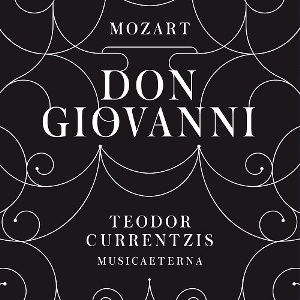Well, we’re safe in the knowledge that Maestro Currentzis has now run out of Mozart-Da Ponte operas. His note-by-note, string-by-string examination of each score has been a wonderful exercise in obsessive-compulsive disorder, an experiment undertaken in Siberia, previously noted for exile and punishment.
This handsomely put-together addition to the Sony catalog features a conversation with Currentzis about Don Giovanni in a Q&A format: the name of the questioner is not offered and I’d swear Currentzis was asking and answering, but enough about that. He proclaims that Don G has not produced one hit aria because it “is more like a treatise than an opera”. Those of us who have been happily going to performances of a treatise will be surprised, and so will tenors who have made “Il mio tesoro” and/or “Dalla sua pace” their concert calling cards. If only he would shut up.
The overall effect of this performance is exhilarating. Many parts of the recordings of Figaro and Cosí were peculiarly whispered into the microphones, as if to project intimacy; it mostly made the singers sound either insane or as if they were saving their voices. Some of that goes on here too, to better effect: the recit before “Là ci darem la mano” is one example, and the serenade is lovely, even if the accompaniment sounds like it’s taking place at a luau.
Tempos, as before, are unreliable. The Don’s “Fin ch’han del vino” whizzes by in 1:15, easily the fastest of the fast, while Elvira’s “In quali eccesi”–just the recit–takes 2:44, a tempo so pokey that the listener forgets who is singing. (Comparisons: 2:16–Gardiner; 2:24–Nézet-Séguin; 1:48–Giulini, three very different conductors, styles, and outlooks.) And if the fortepianist isn’t stopped soon, he’ll interpolate the Proch Variations before “Non mi dir”.
But the crisp, sometimes startlingly pitiless attacks from the strings, along with the stupendous ensemble work and balances, will make even the most stubbornly traditional listener sit up and pay heed–not, I might add, to a treatise, but to an opera. The singers seem to be listening to and responding to one another; every piece of coloratura is in place (as are the mostly interesting, occasionally over-the-top and un-Mozartean embellishments), and I didn’t spot a bit of out-of-tune playing or singing. (A=430; just a bit under modern pitch.)
The two duets for three low voices (the first-act dying of the Commendatore and the last-act pre-death scene) are so well balanced and sung that each strand is audible. The three stage bands in the first-act finale are wonderfully delineated and I don’t mind the willfully “wrong” notes Currentzis asks for.
The vocal casting is a mixed bag. Strangely, the strongest characters come across as Ottavio and Masetto–very determined and nobody’s fool, and Kenneth Tarver is ravishing as the former and Mika Kares is fierce as the latter. Dimitris Tiliakos as Giovanni is youthful and smooth with a true lust for life, but his voice is too light for the part in general; Vito Priante’s Leporello, without mugging, makes more of a vocal impression but remains the servant.
Myrto Papatanasiu is simply too light for Donna Anna. She may be a superb coloratura, and within the confines of a small period-instrument group on a recording her “Or sai chi…” is exciting, but dramatic heft is nowhere to be found. Karina Gauvin is a divine Elvira, making every word and note count–she’s a singer who has not yet made a poor recording. Christina Gansch’s Zerlina is strong-willed enough to sing both of her arias very deliberately.
And so–a quandary. The performance packs a wallop by the end, and you feel as if you’ve been “through” something. But I’m not certain that Mozart and Da Ponte wanted to exhaust their audience, and that’s what happens here. This really should be heard–probably twice–but in the end it does not satisfy as so many other recorded performances do. If it’s period playing you need, René Jacobs’ imaginative, compelling set on Harmonia Mundi is the one; if you’re looking for traditional, the old Giulini (Angel) is the shining example. But you might also try the recent set led by Yannick Nézet-Séguin on DG.
The (somewhat) positive rating I’ve given for this set must be taken with the caveats I’ve stated above. It’s a fascinating curiosity, a roller-coaster ride that you can’t resist, but you’re glad when it’s over.
































